New Chapter for Irish Ferries Newbuild
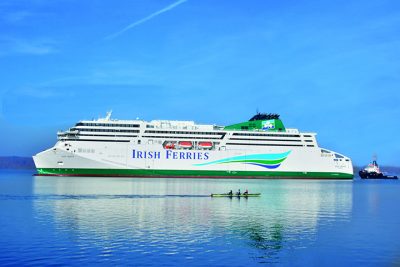
Irish Continental Group announced on Wednesday 12th December that the 51,388gt cruise ferry W.B. Yeats (above) had been delivered to them by Flensburger Schiffbau-Gesselschaft & Co. KG of Flensburg, Germany (FSG), at a contract price of €144 million. The ship can accommodate 1,800 passengers, has 440 spacious cabins including luxury suites and 2,800 lane metres of freight capacity (165 freight vehicles) plus an additional dedicated car deck with capacity for 300 cars. Facilities on board include, continuing the literary theme, the Lady Gregory Restaurant, the Maud Gonne Bar & Lounge and The Abbey and The Peacock cinemas. The W.B. Yeats departed FSG on 15th December on her delivery voyage to undergo commissioning with Irish Ferries and is expected to commence services initially on the Dublin to Holyhead route in early January 2019 before switching to the Dublin-Cherbourg route in March 2019. The ship’s first call was Cherbourg on 18th December for berthing trials before making her maiden arrival at Dublin on 20th December.
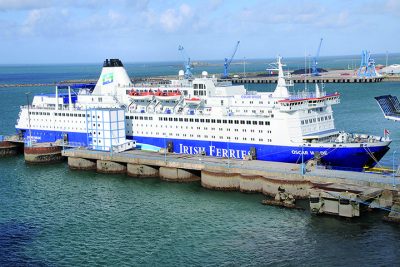
The 31,914gt/1987 built Oscar Wilde (above), formerly Color Line’s Kronprins Harald, faces an uncertain future in the Irish Ferries fleet as Irish Ferries announced prior to Christmas that a Rosslare-Roscoff/ Cherbourg service is unlikely to operate in 2019. The new W.B. Yeats is also apparently too big for the berth at Roscoff so the company looks set to focus on using the newbuild on the Dublin-Cherbourg link on which the ship will sail 125,000 nautical miles per annum, March-September. The W.B. Yeats was scheduled to enter service on 13th January in place of the 50,938gt/2001 built Ulysses, possibly in freight-only mode initially as she was not shown on the passenger booking website. This permitted the Ulysses to go for annual dry docking, returning on 24th January if all goes to plan. The W.B. Yeats will then move to the secondary roster on Dublin-Holyhead in place of the Oscar Wilde. The Epsilon was indicated as replacing the Oscar Wilde from 15th January after her annual refit in Brest with the latter moving to relieve the 34,031gt/1997 built Isle of Inishmore on Pembroke-Rosslare from around 26th January.
Brittany Ferries Newbuild Launched
The 42,500gt/2019 built Honfleur was launched at the Flensburger Schiffbau-Gesselschaft & Co. KG shipyard in Flensburg, Germany, at midday on 14th December. The ship’s hull had been constructed from 118 steel sections prior to launch plus the engines, associated machinery and propulsion units had been fitted. The ship will carry 1,680 passengers and will offer 261 cabins, two cinemas, restaurants, boutique shopping and a choice of spacious passenger lounges. Vehicle capacity is 2,600 lane metres (130 freight trailers, or 550 cars and 64 freight trailers).
The company’s 29,468gt/2009 built Armorique made headlines on 15th December after making heavier than usual contact with the linkspan at Roscoff upon arrival from Plymouth. Passengers had to remain aboard for around 90 minutes after arrival until the jammed stern door was released.
A former Truckline/Brittany Ferries stalwart, the 6,507gt/1978 built Purbeck, has met her end at Puerto la Cruz in Venezuela having partially sunk on 31st December 2018 following a prolonged period of lay-up after owner Conferry ceased trading. Now called the Maria Rosa, the ship met the same fate as her 6,507gt/1978 built sistership Coutances (latterly Rosa Eugenia) did in 2018. Conferry had recently restarted a limited ferry operation whilst most of the fleet had fallen into disrepair.
Potential Ferries Boost
The UK’s Department for Transport (DfT) has signed contracts with Brittany Ferries, DFDS and Seaborne Freight worth in excess of more than £100 million for ferries to ease potential problems in the event of a no-deal Brexit. The additional crossings are understood to be the equivalent to around 10% of the current traffic on the Dover Strait and will involve the ports of Poole, Portsmouth, Plymouth, Immingham and Felixstowe. The move aims to ease pressure on Dover in the event of the UK leaving the EU without a deal. The contract value was reported as £107.7 million, divided between the companies as follows: £47.3 million to DFDS, £46.6m to Brittany Ferries and £13.8 million to Seaborne Freight. DFDS would add capacity to the Immingham-Cuxhaven/ Rotterdam and Felixstowe-Rotterdam services. On 28th December Brittany Ferries outlined steps being taken to change sailing schedules for 2019 in the event of a no-deal Brexit. Nineteen weekly return-sailings will be added to three routes on the western channel: Roscoff to Plymouth, Cherbourg to Poole and Le Havre to Portsmouth. These additional rotations will allow more space for lorries, as requested by the Department for Transport. In total Brittany Ferries will realise a 50% increase in freight capacity on the three affected routes from 29th March, representing a 30% increase overall on the western Channel. The company will also work hard to minimise the impact on existing Brittany Ferries freight customers and passengers, although there may be some changes to some sailing times, for which they apologise in advance. The fact that Seaborne Freight has yet to operate a ferry service across the English Channel was quickly picked up on with questions being asked as to why they were allocated the funds. Perhaps P&O and Stena Line would have been more worthy recipients considering their fleet sizes and operational history. Dredging at Ramsgate Harbour (where Seaborne Freight was expected to operate from) by Van Oord started on 3rd January as already planned and Thanet Council has estimated that a maximum of 24 sailings per day could serve the port if required.

Stena Round Up
On 21st December Stena Line announced the shipment of the 250, 000th freight unit of 2018 on its Dublin-Holyhead route during the Stena Adventurer’s 08.10 sailing from Dublin. The first Stena E-Flexer ship will be delivered to the route in early 2020. Crucially, the new vessel will offer over 3,000 lane metres of freight capacity, a 50% increase on the Stena Superfast X that she will replace.
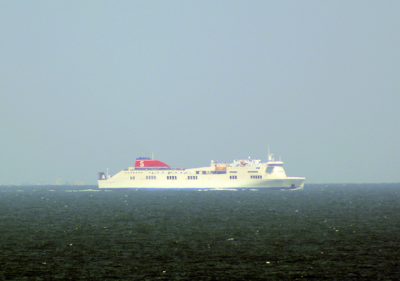
The 27,522gt/2006 built Stena Horizon (above) arrived at Belfast on 31st December to relieve the 27,510gt/2005 built Stena Lagan for her annual dry docking in Belfast, followed by the 27,510gt/2005 built Stena Mersey around 2 weeks later. These duties should conclude on 27th January.
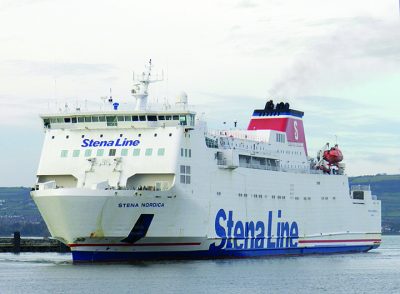
The 24,206gt/2000 built Stena Nordica (above) was due at Rosslare on 1st January to cover for the Stena Horizon and then the refits of the 30,551gt/2002 built Stena Superfast X, 30,285gt/2001 built VII & VIII and the 24,828gt/1981 built Stena Europe. This will see the former P&O Ferries vessel European Ambassador remain on the Irish Sea until the end of May when she returns to the Karlskrona-Gdynia route. The Stena Nordica’s place on the latter service will be taken by the 20,871gt/1979 built Vikingland and then the 10,572gt/1997 built Bore Bay. In the event, the relief duties plan was delayed with the Stena Nordica not starting on the Rosslare-Cherbourg link until 8th January. Owing to a gap in Ireland-France sailings for a number of days due to Irish Ferries & Stena Line refits plus the delay with the Stena Nordica, the Stena Forerunner operated one Rosslare-Cherbourg round trip 5th-6th January. Stena Line announced before Christmas that it was closing the Nynäshamn-Gdynia route at the end of 2018 to focus on the popular Karlskrona-Gdynia route.
A Storm Brewing
Ferguson Marine looks set to commence legal action against the company responsible for CalMac’s fleet of ferries, terminals etc., Caledonian Maritime Assets Ltd. (CMAL), which is run by the Scottish Government, over its £97 million contract to build two new ferries. The shipbuilder is constructing the two vessels for CalMac but progress is months behind schedule. Ferguson Marine has said there have been “unforeseen complexities” with the project, leading to extra costs but CMAL has denied there had been any significant design changes. Ferguson Marine said in a statement that “Due to the repeated unwillingness of CMAL to engage with Ferguson Marine over the additional costs identified due to unforeseen complexities in building the two prototype vessels, we are in discussions with professional claims experts and aim to submit a formal claim to CMAL within the next few weeks.”
CMAL buys and leases the CalMac ships on behalf of the Scottish Government and ordered the two dual fuel vessels to meet growing demand on the country’s ferry network. However, the order is as much as a year behind schedule amid a row over design changes which Ferguson owner Jim McColl had previously claimed has added tens of millions of pounds to the cost. Ferguson Marine has been given a £45 million loan facility by the Scottish Government as a result of the challenges it faces with the contract. CMAL has stated that Ferguson Marine is under contract to supply the design and build of the two ferries and that it is an industry standard design and build contract with a fixed price and defined delivery dates. Ferguson Marine entered into the contract with full and prior knowledge of the specification and terms of the contract. CMAL also fundamentally disagrees with any assertion that there have been significant design changes to the vessels. Minor changes have followed the contractual process and costs for these have been agreed with Ferguson Marine via a 3% project contingency budget held by CMAL. Costs have reportedly risen to £50 million and the shipyard have been quoted saying that the two newbuilds are an albatross around the shipyard’s neck.
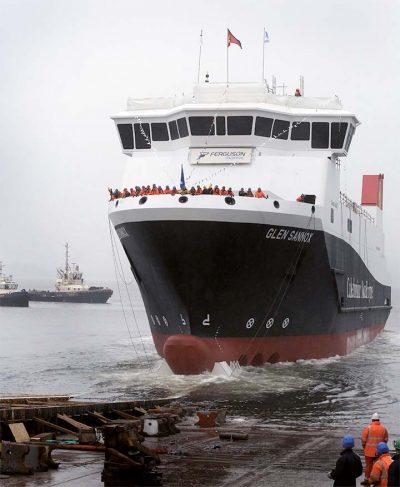
Meanwhile the new ferry Glen Sannox has been launched (above) and is currently fitting out at the yard.

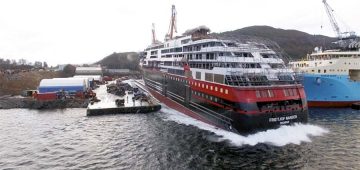




Comments
Sorry, comments are closed for this item